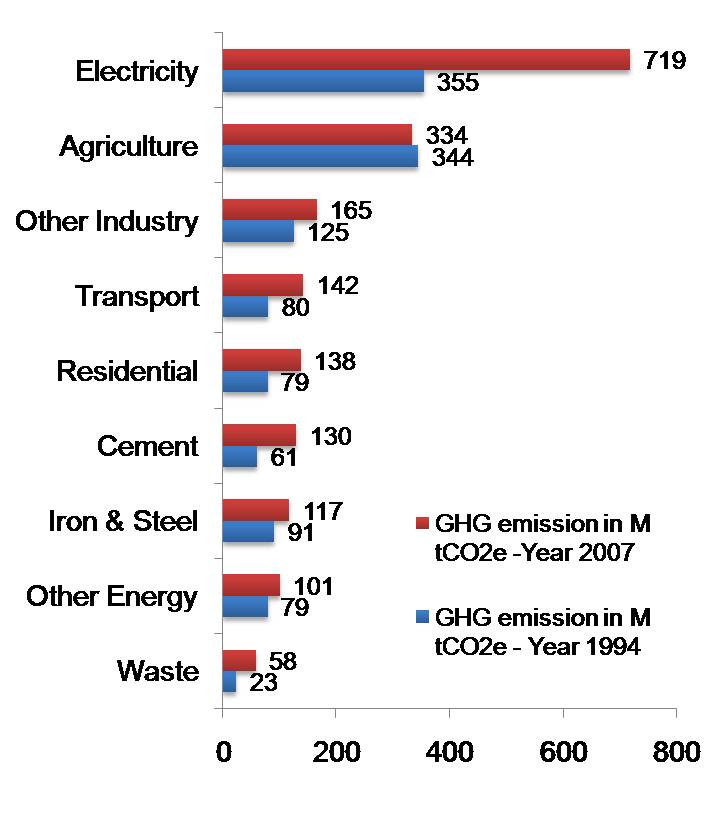Climate change can earn you profit…
Increasing concentration of Green Houses Gases [1](GHGs) mainly due to human activities has resulted into warming of the atmosphere leading to what is known as climate change. Governments all over the world have committed themselves to GHG emission reduction targets to combat the potential effects of climate change. It has resulted into international treaties like the UNFCCC (United Nations Framework Convention on Climate Change) and the Kyoto Protocol and domestic action plans like the National Action Plan on Climate Change of India.
While a convention contains general principles and policy regulations, a protocol is stricter and legally binding. The businesses all over the world are basically driven by availability of natural resources, government policy and changes in consumer demand. Business is obviously affected by the economic, social and cultural requirements of a country, As a result of the different climate policies, companies are required to be ready for complying potential regulatory regimes and also for seeking new opportunities. Companies with better policy on climate change can adapt quickly to gain a competitive advantage.
This offers a fantastic opportunity for innovation and will also reduce costs because better compliance means avoidance of fines in the form of penalties and lower insurance costs by demonstrating better safety standards. Also, the public perception is bound to be increase positively if a company does it bit for the improvement of the environment.
For organizations that generate large quantities of CO2, climate change risks and opportunities are clearly a significant issue that is likely to affect future costs driven by climate regulations. On the other hand, companies can earn good income through better adaptation policies.
In addition, domestic regulatory regime i.e. India’s National Action Plan on Climate Change (NAPCC) creates regulatory framework to reduce the GHG emission. NAPCC enforced the mandatory use of renewable energy and energy efficiency in the existing system, carbon tax on coal, etc. Non compliance with regulations will lead to heavy penalties.
Possible Solution to reduce GHG emission

With global efforts driving national and international policies to limit GHG emissions from the various types of sources, governments are encouraging sustainable growth based on low carbon activities. The first step is to measure the impacts of an organization’s operations on the environment. Carbon footprint is a suitable indicator for this. By committing to it, organizations signal its investors, customers, and other stakeholders that it recognizes climate change as a critical issue for business. The second step is to identify the scope of emission reduction in the organization and prioritizing the areas where the emission reduction is most feasible, both technically and financially. After this stage, an organization can take actions to reduce their emissions by various ways like ensuring energy efficiency, sourcing renewable energy, process redesign for the less emission, plantation activities, etc. Organization may even offset the carbon emission by purchasing Renewable Energy Certificates or Carbon credits.
A company that manages climate change risks and opportunities more effectively may gain a competitive advantage than others in its industry. For example, companies relying on conventional energy sources may face energy shortage in near future due to resource scarcity such as interrupted or no supply of fuel and water as a result of climate change. Therefore, uses of renewable energy may ensure future energy supply for the company. On the other hand, a company that ignores climate risk and doesn’t adapt itself to harness the opportunities may have to bear higher energy costs or make do with no energy at all.
Companies benefiting from better climate policy;
ITC
- First “Carbon Positive” company
- Sustainably managed plantations for paper business ensure continuous raw materials supply and also resulted in Carbon sequestration.
- Energy Conservation activities resulted in savings of more than USD 4mn p.a.
- 30% of energy demand met through renewables resulted in low carbon footprint and also earned carbon credits.
L & T
- Have implemented robust carbon management system and quantified carbon emission as a result of organizations’ operations.
- After mapping of carbon emission, L&T purchases renewable electricity of 54 MWh to ensure the energy supply as well as reduce the carbon footprint.
Wipro
- Ranked No. 2 in the Global 500 listing of Newsweek’s Green Company Rankings 2012
- 80% GHG emission reduction achieved through purchase of RE power and 5% is from its own generation of RE power.
[1] A greenhouse gas is a gas in an atmosphere that absorbs and emits radiation. There are six GHGs i.e. CO2, CH4, N2O, HFC, PFC and SF6



Informative article….. thanks for sharing